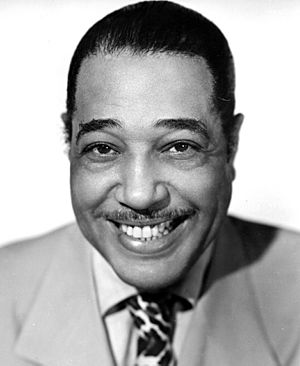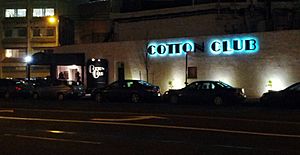Cotton Club facts for kids
The Cotton Club was a famous nightclub in New York City that operated from 1923 to 1940. It was first located in Harlem on 142nd Street and Lenox Avenue, and later moved to the Theater District in Midtown Manhattan.


The club was open during a time in the United States called the Prohibition Era, when selling alcohol was illegal. It also operated during the Jim Crow era, which meant there was racial segregation. This meant that only white people were allowed to be customers at the Cotton Club. However, the club became famous for featuring many of the most popular black entertainers of that time.
Some of the amazing performers who played there included musicians like Duke Ellington, Cab Calloway, Louis Armstrong, and Count Basie. Famous singers like Adelaide Hall, Ethel Waters, and Lena Horne also performed. Dancers such as Bill Robinson and The Nicholas Brothers also graced the stage.
The Cotton Club was a popular spot for celebrities. On "Celebrity Nights," famous guests like George Gershwin, Paul Robeson, and Judy Garland would visit.
Contents
History of the Club
In 1920, a boxing champion named Jack Johnson opened a club in Harlem called the Club Deluxe. In 1923, a powerful businessman named Owney Madden took over the club after being released from prison. He changed its name to the Cotton Club. Madden used the club to sell his beer, even though alcohol was not allowed during Prohibition.
When the club briefly closed in 1925 for selling alcohol, it quickly reopened. It continued to sell drinks to its white guests without problems from the police. The Cotton Club was known for being a "whites-only" place, meaning only white customers were allowed inside, with very few exceptions for black celebrities like Ethel Waters. It was also quite expensive to get in, but the performers were paid very well.
The Harlem Years
The shows at the Cotton Club were called "musical revues," and many were named "Cotton Club Parade." These shows happened twice a year and featured dancers, singers, comedians, and other acts, along with a house band. These revues helped many artists become famous.

Duke Ellington's orchestra was the main band at the club from 1927 to 1931. His first show was called "Rhythmania" and featured the singer Adelaide Hall. The club helped Ellington become famous across the country because his performances were broadcast on the radio. This also allowed him to try out new musical ideas and create many new songs. Over time, the club even slightly relaxed its rule about segregation because of Ellington's influence.
After Ellington, Cab Calloway's orchestra became the house band in 1931. Later, Jimmie Lunceford's band took over in 1934. Famous performers like Ellington, Calloway, and Louis Armstrong returned to the club many times. Lena Horne started as a chorus girl at the Cotton Club when she was just sixteen. Dorothy Dandridge also performed there with her sisters.
A famous "Cotton Club Parade" in 1933 featured Ethel Waters and Duke Ellington performing the song "Stormy Weather." This performance was later included in the 1943 film Stormy Weather, which also featured Lena Horne and Katherine Dunham.
In 1934, Adelaide Hall starred in the "Cotton Club Parade 1934," which was the most successful show the club ever had. It ran for six months and attracted over 600,000 customers. This show featured the classic song "Ill Wind." During Hall's performance of "Ill Wind," a special machine was used to create a fog effect, which was the first time this had been done on a stage.
Moving to Midtown
The Cotton Club temporarily closed in 1936 after a riot in Harlem the year before. It reopened later that year in a new location on Broadway and 48th Street in Midtown Manhattan. The owners were sure the club would do well in this new, busy location.
A newspaper article from 1937 said that the new Cotton Club show gave customers "their money’s worth of sound and color." The most amazing show in the club's history opened in September 1936, featuring Bill Robinson and Cab Calloway along with about 130 other performers. Bill "Bojangles" Robinson was paid $3,500 a week, which was the highest salary ever for a black entertainer in a Broadway show.
In June 1935, the Cotton Club finally started allowing black customers. The club closed permanently in 1940 because of high rent and changing tastes in entertainment.
What People Thought of the Cotton Club
Langston Hughes, a famous writer from the Harlem Renaissance, visited the Cotton Club. He criticized the club because it was segregated. He called it "a Jim Crow club for gangsters and monied whites," meaning it was a club for white people with money, run by people involved in illegal activities, and it kept black people out.
Hughes felt that the club's idea of "authentic black entertainment" was like watching animals in a zoo. He said that white visitors got the best seats to "stare at the Negro customers - like amusing animals in a zoo."
He also believed the Cotton Club hurt the Harlem community. It brought many white people into Harlem at night, which caused smaller, black-owned clubs to close because they couldn't compete with the Cotton Club's big shows and famous entertainers.
Other "Cotton Clubs"
A new version of the Cotton Club opened on 125th Street in Harlem in 1978. It became popular with tourists for jazz brunches on Sundays.
Other Cotton Clubs also opened in different cities, like Chicago and Culver City, California. These clubs sometimes featured performers from the original Harlem club, such as Louis Armstrong and Duke Ellington. There were also Cotton Clubs in Las Vegas, Portland, Oregon, and Lubbock, Texas. The Lubbock club, opened in 1938, was integrated, meaning both black and white customers were allowed. The Las Vegas club, opened in 1944, was a casino and welcomed black servicemen.
The Cotton Club in Pop Culture
The Cotton Club has appeared in many movies, TV shows, and music videos:
- In the 1932 film Taxi!, a fictional club called the Cotton Pickers Club is based on it.
- The music video for Celia Cruz's song "Oye Como Va" features the Cotton Club.
- The 1984 film The Cotton Club tells the story of the club and its connection to the time period.
- The 1988 film Who Framed Roger Rabbit features a fictional Ink and Paint Club, which is based on the Cotton Club.
- The club is mentioned in the book version of the Star Trek: Deep Space Nine episode "Far Beyond the Stars".
- The 2013 Broadway musical After Midnight is about the music from Duke Ellington's time at the Cotton Club.
- In the TV series Luke Cage, a character calls his nightclub "the new Cotton Club."
Images for kids
-
Adelaide Hall, star of the Cotton Club
-
Cab Calloway was another of the original Cotton Club performers
-
Ethel Waters starred at the Cotton Club
-
Lena Horne as a young girl was featured at the Cotton Club
-
Dorothy Dandridge, entertainer at the Cotton Club
See also
 In Spanish: Cotton Club para niños
In Spanish: Cotton Club para niños







